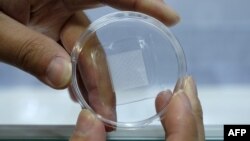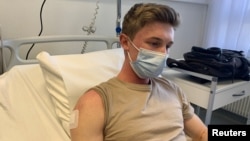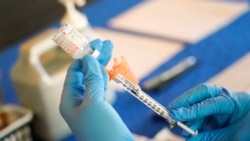Researchers say they have developed a small printing device that can produce vaccine patches for COVID-19 and other diseases.
Since the device is moveable, or mobile, it could be easily deployed to areas of the world that face difficulties receiving and storing vaccines, the scientists say.
Researchers from the Massachusetts Institute of Technology (MIT) led the development of the printer.
While the developers say it will likely take years to become widely available, some experts are calling the technology “exciting.”
Creators of the device recently reported their development results in a study in the publication Nature Biotechnology.
The device prints 2-centimeter-wide patches that each contain hundreds of tiny needles that administer vaccine material when pressed against the skin.
The team says such patches offer major improvements over vaccine shots given in the arm. Users can easily self-administer the vaccines and they are mostly painless. The patches could appeal to people resistant to traditional vaccines. They can also be stored at room temperature for long periods of time.
The popular mRNA COVID-19 vaccines from Pfizer and Moderna need to be kept cold in refrigerators. This has made it hard to get them to parts of the world that lack the ability to keep the medicine cold, especially developing countries. Some of those nations criticized the unequal sharing of vaccine shots during the COVID-19 pandemic.
The researchers said the new printer was tested with the Pfizer and Moderna COVID-19 vaccines. But the goal of the international development team is for the device to be used for other vaccines as well.
Robert Langer is the co-founder of Moderna and one of the study's writers. He told the French press agency AFP he hoped the printer could be used for "the next COVID, or whatever crisis” happens.
Ana Jaklenec is a researcher at MIT and another co-writer of the study. She said in a statement that the devices could someday establish “on-demand vaccine production.”
Jaklenec added, “If, for example, there was an Ebola outbreak in a particular region, one could ship a few of these printers there and vaccinate the people...”
Microneedle patch vaccines are already under development for COVID-19 and a series of other diseases, including polio, measles and rubella. But the patches have long struggled to expand because producing them is a costly, labor-intensive process that often involves large machines.
The researchers developing the new process said they shrank the process down by using smaller equipment to create the patches.
Currently, the team said the printer can produce 100 patches in 48 hours. But researchers say experiments have shown that with improvements, the printer could print thousands a day. "And you can have more than one printer," Langer added.
Joseph DeSimone is a chemist at California’s Stanford University who was not involved in the study. He said the work “is particularly exciting as it realizes the ability to produce vaccines on demand."
DeSimone has invented his own versions of microneedle patches. He said if the printing process can be widely deployed, it can help bring "widespread access to RNA vaccines."
Antoine Flahault directs the Institute of Global Health at the University of Geneva in Switzerland. He told AFP that production and access to vaccines could be "transformed through such a printer."
This, Flahault added, could become a real “breakthrough." Flahault noted, however, that the success of the method will first require government approvals and mass production. And that could take many years.
I’m Bryan Lynn.
Bryan Lynn wrote this story for VOA Learning English, based on reports from Agence France-Presse and the Massachusetts Institute of Technology.
____________________________________________________
Words in This Story
patch – n. a piece of material used to cover a hole in clothes or other material
needle – n. the thin, sharp metal part of a piece of medical equipment used to put medicine in the body
region – n. a particular area in a country or the world
access – n. permission to enter or use something
transform – v. to change something completely, usually to improve it
breakthrough – n. an important discovery
What do you think of this story? We want to hear from you. We have a new comment system. Here is how it works:
- Write your comment in the box.
- Under the box, you can see four images for social media accounts. They are for Disqus, Facebook, Twitter and Google.
- Click on one image and a box appears. Enter the login for your social media account. Or you may create one on the Disqus system. It is the blue circle with “D” on it. It is free.
Each time you return to comment on the Learning English site, you can use your account and see your comments and replies to them. Our comment policy is here.










Forum